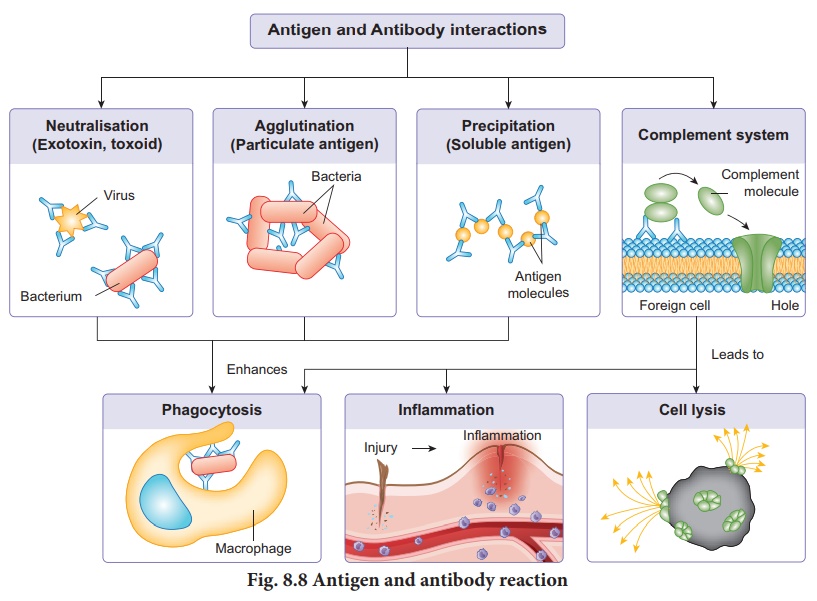Immunology - Antigen and antibody interaction | 12th Zoology : Chapter 8 : Immunology
Chapter: 12th Zoology : Chapter 8 : Immunology
Antigen and antibody interaction
Antigen and antibody interaction
The reaction between an antigen and antibody is
the basis for humoral immunity or antibody mediated immunity. The reaction
between antigen and antibody occurs in three stages. During the first stage,
the reaction involves the formation of antigen - antibody complex. The next
stage leads to visible events like precipitation, agglutination, etc., The
final stage includes destruction of antigen or its neutralization (Fig.
8.8).

Binding force of antigen - antibody reaction
The binding force between antigen and antibody
is due to three factors. They are closeness between antigen and
antibody, non-covalent bonds or intermolecular forces and affinity of antibody.
When antigen and antibody are closely fitted,
the strength of binding is great. When they are apart binding strength is
low.The bonds that hold the antigen to the antibody combining site are all non-covalent
in nature. These include hydrogen bonds, electrostatic bonds, Van der
Waals forces and hydrophobic bonds. Antibody affinity is the
strength of the reaction between a single antigenic determinant and a single
combining site on the antibody.
The chief application of antigen -
antibody reactions are to determine blood groups for transfusion, to study
serological ascertainment of exposure to infectious agents, to develop
immunoassays for the quantification of various substances, to detect the
presence or absence of protein in serum and to determine the characteristics of
certain immunodeficiency diseases.
Different types of antigen and antibody reactions
The reaction between soluble antigen and
antibody leads to visible precipitate formation, which is called precipitin
reaction. Antibodies that bring about precipitate formation on reacting
with antigens are called as precipitins.
Whenever a particulate antigen interacts
with its antibody, it would result in clumping or agglutination of
the particulate antigen, which is called agglutination reaction.
The antibody involved in bringing about agglutination reaction is called agglutinin.
Opsonisation or enhanced attachment is the process by which a pathogen is marked of ingestion and destruction by a phagocyte. Opsonisation involves the binding of an opsonin i.e., antibody, to a receptor on the pathogen’s cell membrane. After opsonin binds to the membrane, phagocytes are attracted to the pathogen. So, opsonisation is a process in which pathogens are coated with a substance called an opsonin, marking the pathogen out for destruction by the immune system. This results in a much more efficient phagocytosis.
The neutralization reactions are the reactions of antigen-antibody that involve the elimination of harmful effects of bacterial exotoxins or a virus by specific antibodies. These neutralizing substances i.e., antibodies are known as antitoxins. This specific antibody is produced by a host cell in response to a bacterial exotoxin or corresponding toxoid (inactivated toxin).
Related Topics